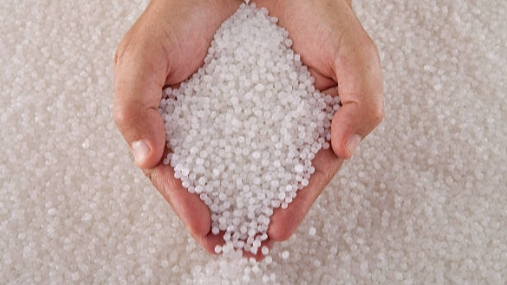PLA molecular chain rigidity is large, so the crystallization rate is slow, in the conventional molding process to get the product crystallinity is low, and thus has a low heat distortion temperature (HDT).PLA glass transition temperature is about 60 ℃, due to the low crystallinity, the temperature reaches near the glass transition temperature, the PLA will be deformed, and therefore shows poor heat resistance, which makes PLA can not be used to make products used at high temperature This prevents PLA from being used to make products that are used at high temperatures, such as food containers, household appliances, electronic products, and automotive parts. Therefore, it is of practical importance to improve the heat resistance of PLA.

1 Chemical copolymerization
The introduction of long-chain branched structure (LCB) increases the entanglement and nucleation ability between PLA molecular chains, which is conducive to improving the melt strength and crystallization ability of PLA. 0.3 wt% peroxide-modified PLA and 0.8 wt% epoxidized cashew nut phenol prepared by LCBPLA (PLA/0.3T/0.8E), after a simple annealing treatment, the crystallinity of the LCBPLA reaches around 40% and the Vicat softening temperature (VST) was increased to 156.2°C, which significantly improved the heat resistance of the material. However, due to the change of the molecular structure of PLA, it may lead to the decrease of its degradation properties. Chemical copolymerization is more complicated and costly than blending, and is not suitable for industrial production.
2 Crosslinking modification
After crosslinking the PLA molecular chain, its ability to move will be limited by the crosslinking point, so it needs to absorb more energy from the outside world to get rid of the bondage, macroscopically, it is manifested in the improvement of the heat resistance of PLA.
When the mass ratio of PLA/EVOH is 60/40, the content of triallyl isocyanurate (TAIC) is 5 wt%, and the amount of γ-ray radiation is 50 kGy, the HDT of the copolymer is increased to about 140 ℃, which is twice as much as that of the pure PLA, and the heat resistance of the material is significantly improved.
At diisopropylphenyl peroxide (DCP) addition of more than 0.5%, DCP-induced PLA cross-linking occupies a dominant position in the system. During melt blending, a significant elevation of torque occurs and the material viscosity increases significantly. After cross-linking, some PLA will not melt, and these PLA that do not melt will provide nucleation sites for PLA crystallization, improving the crystallization rate and crystallinity of PLA. After annealing, the Vicat softening temperature (VST) of PLA/DCP blends is increased from 59°C to 155°C for pure PLA, which significantly improves the heat resistance.
3 Blending
3.1 Addition of nucleating agents
The addition of some nucleating agents will significantly shorten the crystallization time and significantly increase the crystallinity, thus significantly improving the heat resistance of PLA. Nucleating agents are mainly divided into two categories: inorganic and organic. Commonly used inorganic nucleating agents are talc, mica, calcium carbonate and barium sulfate. Organic nucleating agents mainly include sorbitol and amide compounds.
D-sorbitol was added to PLLA as a nucleating agent by melt blending, and the heat deflection temperature (HDT) of PLLA was increased from 56°C to 132°C, an increase of 76°C, when the mold temperature was raised to 90°C without other heat treatment operations.
TMC-328 (a polyamide compound) was used as a nucleating agent, and PLA/TMC-328 blends were prepared by melt blending. After adding 0.2 wt% of TMC-328, the PLA blend system had a large number of nucleation sites, and its Vicat softening temperature increased to 134 °C, which was 2.1 times higher than the Vicat softening temperature (64.7 °C) of pure PLA.
Improving the crystallinity of the products by adding the corresponding nucleating agent to PLA and then heat-resistant modification is the most commonly used method in current research, because this method is low cost, simple, efficient, and has various processing methods, but because the added nucleating agent is usually a small molecule, there is a possibility that the nucleating agent will precipitate out of the products when they are used for a long period of time.
3.2 Blending with inorganic particles
Inorganic particles usually have high rigidity as well as heat resistance, therefore, by blending with inorganic particles, the heat resistance of PLLA will be improved to some extent.
A series of PLLA/PDLA/ADP blends were prepared by melt blending equal mass ratios of PLLA and PDLA with different mass fractions of aluminum diethyl phosphite (ADP). As shown by the results of heat deflection temperature (HDT) tests, the HDT of PLLA/PDLA/ADP blends were 56.9 and 13.6 °C higher than that of pure PLLA (113.5 °C) and PLLA/PDLA (156.8 °C), respectively, which indicated that the incorporation of ADP significantly improved the heat resistance of PLA and its blends.
The PLA/PBS blends with 5% glass fiber GF added showed the greatest increase in Vickers softening temperature of 122.1 °C, which was 5.3% higher than that of PLA/PBS blends; the Vickers softening temperatures of PLA/PBS blends with GF/SiO2 and GF/PAC added were also higher than those of PLA/PBS blends.
The addition of inorganic particles can effectively improve the heat resistance of PLA, but the inorganic particles are prone to agglomeration, which may adversely affect the transparency and mechanical properties of PLA, so it is particularly important to improve the dispersion of inorganic particles in PLA.
3.3 Formation of cubic crystals
When PLLA is blended with PDLA in equal proportions, cubic crystals (SC-PLA) can be formed.The melting point of SC-PLA is about 230°C, which is about 50°C higher than the melting point of PLLA and PDLA (about 175°C). When the temperature is below the melting point of PLA, SC-PLA can be used as a nucleating agent to provide a large number of nucleation sites for PLA crystallization, resulting in an increase in the crystallization rate of PLA and an increase in the degree of crystallinity, thereby improving the heat resistance of PLA. Therefore, in the current research of PLA heat-resistant modification, it is also one of the research hotspots to improve the heat resistance of PLA by forming cubic crystals.
PLLA was blended with PDLA of different molecular weights to prepare PLA materials with excellent heat resistance.The Vickers softening temperature (VST) of PLLA was increased to about 150 °C, which is about 90 °C higher than that of pure PLLA (63.9 °C), and the content of SC crystals in the system increased with the increase of the addition of PDLA, so that it can improve the heat resistance of PLA substantially.
The HDT of pure PLLA was 82°C, the HDT of PLLA/PDLA/E-MA-GMA (without catalyst) blends was 121°C, and the HDT of PLLA/PDLA/E-MA-GMA (with catalyst) was 174°C. The thermal stability of PLA increased with the increase of SC crystal content.
From the above study, it can be seen that the addition of PDLA can form cubic crystals with PLLA thus effectively improving the heat resistance of PLA. The higher the content of cubic crystals, the more significant the improvement of heat resistance of the system. However, there is a competitive relationship between the formation of structural crystals in the system and the crystallization of the body, so how to improve the content of structural crystals in the material is currently a hot research topic.
3.4 Blending with high heat-resistant polymers
High glass transition temperature or high crystallinity polymers can be added to PLA to improve its heat resistance, such as nylon (PA), polycarbonate (PC), polyoxymethylene (POM), polymethyl acrylate (PMMA) and so on.
These added polymer materials are usually less compatible with PLA, and the two phases after blending have obvious phase interfaces and form a large phase region, which may cause a decrease in the mechanical properties of PLA, and when too much is added, it will likewise reduce the degradability of PLA.
4 External field effects
4.1 Heat treatment
Appropriately increasing the annealing temperature and increasing the annealing time can improve the crystallinity of PLA, improve the crystallization ability of PLA, and then make improvements to the heat resistance of PLA.
The crystallinity of PLA after annealing at 80°C for 0.5h is 6.7%, and when the annealing time grows to 2h, the crystallinity increases to 28.9%. It can be seen that the increase in annealing time helps to improve the crystallinity of PLA; the crystallinity of PLA samples annealed at 120°C for 2h is 43.8%, which proves that the increase in annealing temperature is also conducive to the improvement of crystallinity; in contrast, the crystallinity of PLA samples that have not been heat-treated is only 4.2%.
4.2 Stretching
Drawing is another common means of improving the crystallization ability of polymers, as well as improving the strength and heat resistance of polymers.
The glass transition temperature of the sample with 20 wt% PDLA increased by 5°C compared to the pure PLLA sample, and the glass transition temperature of the drawn sample was about 20°C higher than that of the undrawn sample. At the same time, the fibrous PDLA plays the role of skeleton support, restricts the movement of PLLA molecular chains, and limits the occurrence of deorientation of oriented PLLA, thus improving the heat resistance of PLLA.
By melt blending PLA with 0.5 wt% of N1,N1'-(ethane-1,2-diyl)bis(N2-phenyl-oxamide) (OXA, nucleating agent), the application temperature of PLA can be expanded from 70 °C to at least 150 °C by the combination of needle nucleation template and solid-state uniaxial thermal stretching technology, resulting in the improvement of PLA heat resistance.
5 Conclusion
As one of the bio-based biodegradable polymer materials with development potential, the disadvantage of poor heat resistance of PLA has severely limited the application of PLA in high-temperature environments. The development of high-performance and highly heat-resistant PLA-based materials is of great significance. The heat resistance of PLA can be improved by chemical copolymerization, cross-linking, incorporation of nucleating agents, inorganic particles, preparation of cubic crystals, blending with highly heat-resistant polymers, and application of external fields (heat treatment, stretching).
Among these methods, chemical copolymerization is more complex and costly compared to blending; cross-linking methods may affect the processing and degradation properties of the material. Blending with bio-based nucleating agents, inorganic particles, poly(dextro-lactic acid), and highly heat-resistant biodegradable polymers and combining with external field action is one of the modification methods with research value. With the industrialized production of PLA, the preparation of fully degradable and high-performance will have a broad application prospect.

Please feel free to contact us.
Email: sales@tgb-solution.com
文章来源:生物降解材料研究院
 English
English 日本語
日本語 한국어
한국어 français
français Deutsch
Deutsch Español
Español русский
русский português
português العربية
العربية ไทย
ไทย Malay
Malay






















